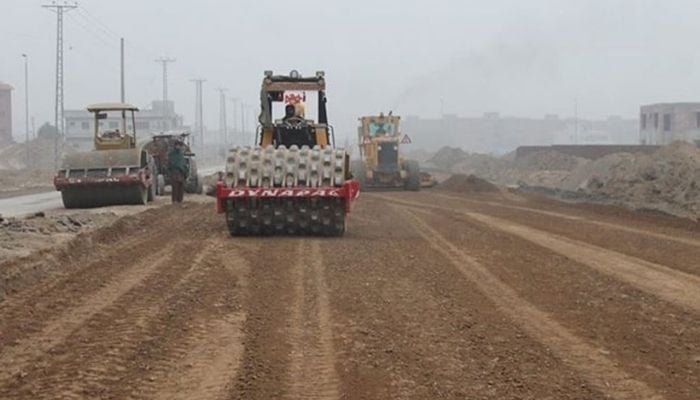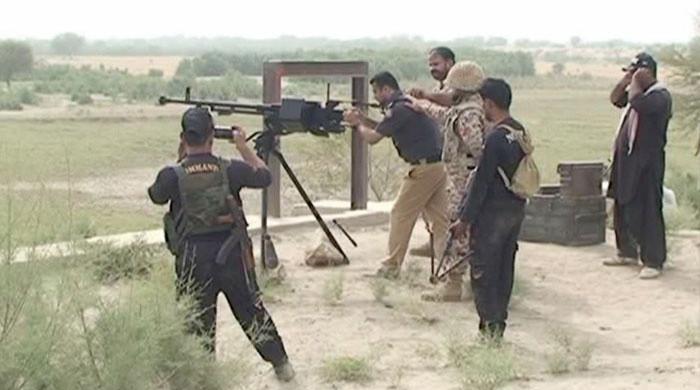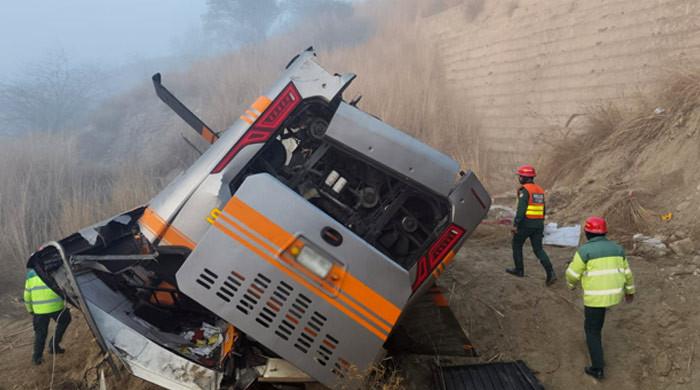Sindh govt admits Malir Expressway work began without approval
Infamous for being a toothless organisation, Sepa turned a blind eye towards the admission of this blatant violation of the law
March 10, 2022

- Sindh govt kicked off Malir Expressway work without letting Sepa give it a go, Sindh govt official admits.
- Sepa turned a blind eye towards the admission of this blatant violation, says report.
- Approval from the environmental watchdog is a must before starting any construction work, says report.
The public hearing for the Malir Expressway project on Wednesday became a laughing stock when a Sindh government official present there conceded to have kicked off construction work on a 15-kilometre strip of the project without first letting the Sindh Environmental Protection Agency (Sepa) give it a go.
Infamous for being a toothless organisation, Sepa turned a blind eye towards the admission of this blatant violation of the law during the public hearing for the project.
Meanwhile, Sepa Director General Naeem Mughal, who has earned the reputation for never showing up on public hearings, was absent this time as well as he was during the public hearings for the Karachi Circular Railway on November 10, and for the restoration of Gujjar, Orangi and Mehmoodabad storm water drains on December 1.
The approval from the environmental watchdog is a must before starting any construction work for development projects. In this regard, Muhammad Toheed, a senior researcher of the Institute of Business Administration’s Urban Lab, cited the Section 17(1) of the Sepa Act 2014 that reads: “No proponent of a project shall commence construction or operation unless he has filed with the Agency an IEE or EIA, & has obtained from the Agency approval in respect thereof.”
He wondered how construction work on ground had already kicked off and a camp office also established without obtaining Sepa’s approval. Pictures and videos of the ground-levelling work were shown repeatedly to Sepa Deputy Director Imran Sadiq who made no comments on that.
Sepa has miserably failed to implement its section 17(1) repeatedly. The demolition of houses along the railway track kicked off much before the public hearing for the KCR that was held last year. Likewise, when the Environmental Impact Assessment (EIA) report for the restoration of the Gujjar, Orangi and Mehmoodabad drains was formulated, thousands of families had already been rendered homeless almost a year ago.
A resident of Malir, Shafi Baloch, pointed out that Sepa’s approval was not obtained in the PC-1 for the Malir Expressway project. He said that during the preparation of the PC-1, the provincial government obtained NOCs from 35 different governmental bodies but not Sepa.
“Is this public hearing even legal?” Shafi asked and added that Mughal should have appeared at the event to conduct the hearing himself.
At this point, the project’s PC-1 has been approved, tender process completed and contracts awarded. Now, if due to Sepa’s objections, the cost gets revised, Shafi said, officials involved in the project and the provincial government would be on the radar of the National Accountability Bureau.
The project
The Malir Expressway, according to its EIA report, is a 30-kilometre-long corridor linking Defense Housing Authority (DHA) with the Karachi-Hyderabad Motorway. The project’s cost is estimated at Rs27.5 billion.
The Sindh government has formed a company, Malir Expressway Private Limited, to undertake the project. The company hired the National Engineering Services Pakistan (NESPAK) and EMC Pakistan for the project’s study and preparation of the EIA report.
As per the report, nearly 120 acres of private land have to be obtained for the project, which would also affect over 2,330 acres of agriculture land where vegetables and fodders are cultivated. Some 1,800 to 1,900 plants and trees of different forms will also be removed.
Contradictory claim
In the EIA report, the EMC has mentioned that 345 houses, 31 shops and a few mosques will have to be demolished for the project. However, during the public hearing, an EMC official claimed that hardly seven to eight homes would be destroyed. Toheed believes this to be eyewash.
Advocate Anees Dilmurad, who is also a resident of the area, shared how 24 villages would be severely affected due to the project.
However, the report does not clearly mention the mechanism of resettlement of affected people. The table 9.3 in the EIA report has an empty compensation and resettlement cost column. The report reads that the cost would be incorporated based on the actual loss measured during the final land acquisition by the Board of Revenue, no official of which was present at the hearing.
Indigenous people
In the EIA report, the EMC has declared that none of the affected residents are indigenous, said Karachi Bachao Tehreek’s Aadil Ayub.
In the section 384 of the report, it is mentioned that no indigenous people were found along the project’s corridor. To this, Dilmurad shared how Baloch, Jokhio, Khaskheli and fishermen community have been residing in the project’s area since 1914 when the British had demarcated their villages.
Gender issues
Participants at the hearing also pointed out gender issues in the EIA report. Ayub mentioned that the document maintained that the project could result in gender-based violence (GBV) but all the awareness sessions regarding the GBV were directed towards the community and not the workers of the project who were likely to be the source of violence.
Toheed pointed out how for such a mega project, the EIA consultants only selected a sample size of 240 respondents, of whom 91% were male and 9% female. “For the purpose of demolition, they can bulldoze the entire settlements but for surveys, they fear talking to women,” he said.
Shafi said that the sample size of 240 was quite less as the project stretched from Qayyumabad all the way to Kathore and encompassed four to five National Assembly constituencies and eight to 10 Sindh Assembly constituencies of Karachi. He termed the survey anti-public.
He also pointed out how the Sepa website was down for 10 days and residents of the area were not able to access the report to read it beforehand. “Ironically just on the day of the public hearing, the website started working,” he said.
Wildlife
A wildlife photographer and Malir resident, Salman Ahmed Baloch, alleged that the EIA report seemed to be nowhere near the ground reality when it came to wildlife data.
He said that in table 5.16 of the report, there was mention of only 16 bird species found in the project area. He claimed that he had himself recorded 176 bird species in only one spot of the project, Memon Goth.
He added that the EIA was a failure as it did not mention butterfly species when it talked about biodiversity in the report. A total of 73 butterfly species would be affected due to the project, he said. He further criticised the EIA report for stating that there was no endangered species in the area. He pointed out that multiple endangered species were spotted there such as the Egyptian vulture. Similarly, he disputed the number of reptile species stated in the report.
Salman contended that the report wrongly mentioned that four tube wells would be affected due to the project. He said that after a field visit of the alignment route, it was learnt that 27 tube wells that were of agricultural use would be affected. Towards the end of the hearing, Sadiq began avoiding taking questions from the participants. As the hearing was called off, scores of residents blocked Sharea Faisal in protest, causing a massive traffic jam.
Originally published in The News









